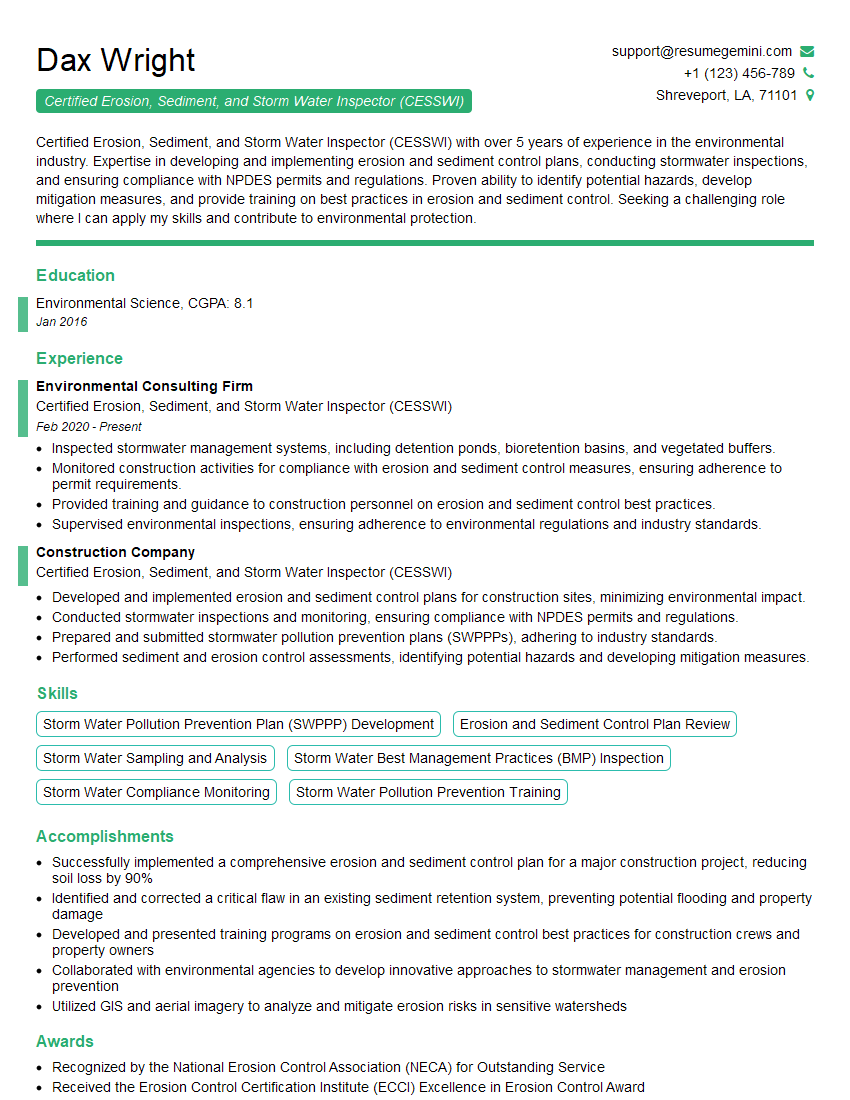Are you a seasoned Certified Erosion, Sediment, and Storm Water Inspector (CESSWI) seeking a new career path? Discover our professionally built Certified Erosion, Sediment, and Storm Water Inspector (CESSWI) Resume Template. This time-saving tool provides a solid foundation for your job search. Simply click “Edit Resume” to customize it with your unique experiences and achievements. Customize fonts and colors to match your personal style and increase your chances of landing your dream job. Explore more Resume Templates for additional options.

Dax Wright
Certified Erosion, Sediment, and Storm Water Inspector (CESSWI)
Summary
Certified Erosion, Sediment, and Storm Water Inspector (CESSWI) with over 5 years of experience in the environmental industry. Expertise in developing and implementing erosion and sediment control plans, conducting stormwater inspections, and ensuring compliance with NPDES permits and regulations. Proven ability to identify potential hazards, develop mitigation measures, and provide training on best practices in erosion and sediment control. Seeking a challenging role where I can apply my skills and contribute to environmental protection.
Education
Environmental Science
January 2016
Skills
- Storm Water Pollution Prevention Plan (SWPPP) Development
- Erosion and Sediment Control Plan Review
- Storm Water Sampling and Analysis
- Storm Water Best Management Practices (BMP) Inspection
- Storm Water Compliance Monitoring
- Storm Water Pollution Prevention Training
Work Experience
Certified Erosion, Sediment, and Storm Water Inspector (CESSWI)
- Inspected stormwater management systems, including detention ponds, bioretention basins, and vegetated buffers.
- Monitored construction activities for compliance with erosion and sediment control measures, ensuring adherence to permit requirements.
- Provided training and guidance to construction personnel on erosion and sediment control best practices.
- Supervised environmental inspections, ensuring adherence to environmental regulations and industry standards.
Certified Erosion, Sediment, and Storm Water Inspector (CESSWI)
- Developed and implemented erosion and sediment control plans for construction sites, minimizing environmental impact.
- Conducted stormwater inspections and monitoring, ensuring compliance with NPDES permits and regulations.
- Prepared and submitted stormwater pollution prevention plans (SWPPPs), adhering to industry standards.
- Performed sediment and erosion control assessments, identifying potential hazards and developing mitigation measures.
Accomplishments
- Successfully implemented a comprehensive erosion and sediment control plan for a major construction project, reducing soil loss by 90%
- Identified and corrected a critical flaw in an existing sediment retention system, preventing potential flooding and property damage
- Developed and presented training programs on erosion and sediment control best practices for construction crews and property owners
- Collaborated with environmental agencies to develop innovative approaches to stormwater management and erosion prevention
- Utilized GIS and aerial imagery to analyze and mitigate erosion risks in sensitive watersheds
Awards
- Recognized by the National Erosion Control Association (NECA) for Outstanding Service
- Received the Erosion Control Certification Institute (ECCI) Excellence in Erosion Control Award
- Named the Certified Erosion, Sediment, and Storm Water Inspector (CESSWI) of the Year by the International Erosion Control Association (IECA)
- Honored by the American Society of Civil Engineers (ASCE) for Contributions to the Field of Erosion Control
Certificates
- Certified Erosion, Sediment, and Storm Water Inspector (CESSWI)
- Certified Professional in Erosion and Sediment Control (CPESC)
- Certified Stormwater Inspector (CSI)
- Certified Erosion Control Specialist (CECS)
Career Expert Tips:
- Select the ideal resume template to showcase your professional experience effectively.
- Master the art of resume writing to highlight your unique qualifications and achievements.
- Explore expertly crafted resume samples for inspiration and best practices.
- Build your best resume for free this new year with ResumeGemini. Enjoy exclusive discounts on ATS optimized resume templates.
How To Write Resume For Certified Erosion, Sediment, and Storm Water Inspector (CESSWI)
- Showcase your technical expertise in erosion and sediment control, stormwater management, and environmental regulations.
- Highlight your experience in developing and implementing erosion and sediment control plans, conducting stormwater inspections, and preparing SWPPPs.
- Emphasize your understanding of NPDES permits and regulations, and your ability to ensure compliance.
- Demonstrate your communication and interpersonal skills, as you will be working with a variety of stakeholders, including contractors, developers, and regulators.
Essential Experience Highlights for a Strong Certified Erosion, Sediment, and Storm Water Inspector (CESSWI) Resume
- Developed and implemented erosion and sediment control plans for construction sites, ensuring compliance with NPDES permits and regulations.
- Conducted stormwater inspections and monitoring to ensure compliance with NPDES permits and regulations.
- Prepared and submitted stormwater pollution prevention plans (SWPPPs), adhering to industry standards.
- Performed sediment and erosion control assessments, identifying potential hazards and developing mitigation measures.
- Inspected stormwater management systems, including detention ponds, bioretention basins, and vegetated buffers.
- Monitored construction activities for compliance with erosion and sediment control measures, ensuring adherence to permit requirements.
- Provided training and guidance to construction personnel on erosion and sediment control best practices.
Frequently Asked Questions (FAQ’s) For Certified Erosion, Sediment, and Storm Water Inspector (CESSWI)
What is a Certified Erosion, Sediment, and Storm Water Inspector (CESSWI)?
A CESSWI is a professional who has been trained and certified to conduct erosion and sediment control inspections and ensure compliance with NPDES permits and regulations.
What are the responsibilities of a CESSWI?
CESSWIs are responsible for developing and implementing erosion and sediment control plans, conducting stormwater inspections, preparing SWPPPs, and providing training on best practices in erosion and sediment control.
What are the qualifications for a CESSWI?
CESSWIs typically have a degree in environmental science, engineering, or a related field, and have experience in erosion and sediment control.
What are the benefits of becoming a CESSWI?
Becoming a CESSWI can enhance your career prospects in the environmental field, and provide you with the knowledge and skills to protect water quality and the environment.
How can I become a CESSWI?
To become a CESSWI, you must pass an exam administered by the National Institute for Certification in Engineering Technologies (NICET).